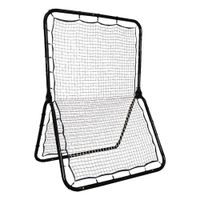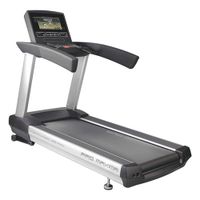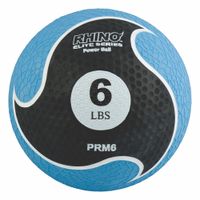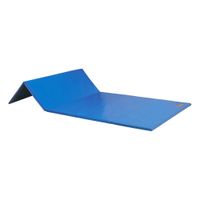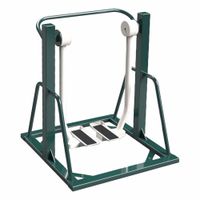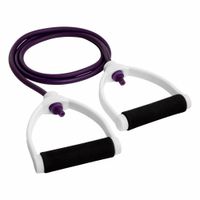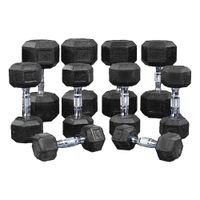Call +(254) 703 030 000 / 751 483 999 / 721 704 777
- Home
- Furnishings Appliances Hospitality
- Fitness Sports Recreation
- Exercise Equipment
Frequently Asked Questions
What are the benefits of using cardio equipment for exercise?
Using cardio equipment for exercise offers numerous benefits, including:
1. **Improved Cardiovascular Health**: Regular use of cardio equipment like treadmills, stationary bikes, and ellipticals strengthens the heart and improves circulation, reducing the risk of heart disease.
2. **Weight Management**: Cardio exercises burn calories efficiently, aiding in weight loss and helping maintain a healthy weight when combined with a balanced diet.
3. **Increased Endurance**: Consistent cardio workouts enhance stamina and endurance, making daily activities easier and less tiring.
4. **Enhanced Lung Capacity**: Cardio exercises improve lung function and capacity, leading to better oxygen intake and utilization.
5. **Stress Reduction**: Engaging in cardio workouts releases endorphins, which are natural mood lifters, helping to reduce stress and anxiety.
6. **Improved Sleep**: Regular cardio exercise can lead to better sleep quality and help regulate sleep patterns.
7. **Boosted Immune System**: Regular physical activity, including cardio, can strengthen the immune system, making the body more resilient to illnesses.
8. **Better Blood Sugar Control**: Cardio exercises help regulate blood sugar levels, which is beneficial for managing or preventing type 2 diabetes.
9. **Increased Bone Density**: Weight-bearing cardio exercises, such as walking or running on a treadmill, can improve bone density and reduce the risk of osteoporosis.
10. **Convenience and Accessibility**: Cardio equipment is widely available in gyms and for home use, providing a convenient way to exercise regardless of weather conditions.
11. **Customizable Workouts**: Most cardio machines offer adjustable settings, allowing users to tailor workouts to their fitness levels and goals.
12. **Low Impact Options**: Equipment like ellipticals and stationary bikes offer low-impact workouts, reducing stress on joints and minimizing injury risk.
How does strength training equipment aid in muscle building?
Strength training equipment aids in muscle building by providing resistance, which is essential for muscle hypertrophy. When muscles are subjected to resistance, they experience microscopic tears. The body repairs these tears by fusing muscle fibers, leading to increased muscle mass and strength. Equipment like free weights, machines, and resistance bands offer varied resistance levels, allowing for progressive overload, a key principle in muscle building.
Free weights, such as dumbbells and barbells, engage multiple muscle groups and stabilizing muscles, promoting balanced muscle development. Machines, on the other hand, provide guided motion, reducing the risk of injury and allowing for isolation of specific muscles. This isolation is beneficial for targeting weaker muscles and ensuring balanced growth. Resistance bands offer variable resistance throughout the range of motion, enhancing muscle activation and endurance.
Strength training equipment also allows for a wide range of exercises, targeting different muscle groups. This variety prevents plateaus by continually challenging the muscles in new ways. Equipment can be adjusted to increase resistance as strength improves, ensuring continuous muscle adaptation and growth.
Moreover, equipment facilitates proper form and technique, crucial for effective muscle building and injury prevention. Machines often come with instructions and settings that guide users, making them suitable for beginners. Advanced lifters benefit from equipment that allows for heavy lifting, essential for stimulating muscle growth.
In summary, strength training equipment provides the necessary resistance, variety, and safety to effectively build muscle. It supports progressive overload, targets specific muscles, and accommodates all fitness levels, making it an indispensable tool in muscle building.
What are outdoor fitness stations and how do they work?
Outdoor fitness stations are exercise equipment installations found in public parks, trails, or recreational areas, designed to promote physical activity in an open-air environment. These stations typically include a variety of equipment that targets different muscle groups and fitness levels, allowing users to perform a full-body workout without the need for a gym membership.
The equipment is often made from durable materials like steel or heavy-duty plastic to withstand weather conditions and frequent use. Common components include pull-up bars, parallel bars, sit-up benches, balance beams, and resistance machines. Some stations also feature instructional signage to guide users on how to perform exercises correctly and safely.
Outdoor fitness stations work by providing a structured environment where individuals can engage in strength training, cardiovascular exercises, flexibility routines, and balance workouts. They are designed to be user-friendly, catering to a wide range of ages and fitness levels. Users can perform exercises such as push-ups, pull-ups, dips, leg raises, and more, often using their body weight as resistance.
These stations encourage community engagement and social interaction, as they are accessible to everyone and often located in communal spaces. They promote a healthy lifestyle by making exercise more convenient and enjoyable, reducing barriers such as cost and accessibility that might prevent people from working out.
Overall, outdoor fitness stations offer a versatile and inclusive way to improve physical health, enhance mental well-being, and foster a sense of community, all while enjoying the benefits of being outdoors.
How do exercise balls improve balance and stability?
Exercise balls improve balance and stability by engaging core muscles, enhancing proprioception, and promoting dynamic movement. When you sit or perform exercises on an unstable surface like an exercise ball, your body must constantly adjust to maintain balance. This activates the core muscles, including the abdominals, obliques, and lower back, which are crucial for stability.
The instability of the ball requires continuous micro-adjustments, which enhances proprioception—the body's ability to sense its position in space. Improved proprioception leads to better coordination and balance, as the body becomes more adept at responding to changes in position and maintaining equilibrium.
Using an exercise ball also encourages dynamic movement, as opposed to static exercises on a stable surface. This dynamic movement challenges the body to stabilize itself in multiple planes of motion, further enhancing balance and stability. Additionally, exercise balls can be used for a variety of exercises that target different muscle groups, promoting overall muscular balance and reducing the risk of injury.
Incorporating an exercise ball into workouts can also improve posture. Sitting on a ball requires an upright position, engaging the core and back muscles, which can lead to better postural habits over time. This improved posture contributes to overall stability and balance in daily activities.
Overall, exercise balls provide a versatile and effective tool for enhancing balance and stability by engaging core muscles, improving proprioception, and promoting dynamic movement.
Why are exercise mats and wall padding important for workouts?
Exercise mats and wall padding are crucial for workouts due to safety, comfort, and performance enhancement. Exercise mats provide a cushioned surface that reduces the risk of injury by absorbing impact during high-intensity activities, such as jumping or weightlifting. This cushioning protects joints, particularly knees and ankles, from stress and strain. Additionally, mats offer a non-slip surface, preventing accidents caused by slipping, especially during exercises that require balance and stability, like yoga or Pilates.
Comfort is another significant benefit. Mats create a barrier between the hard floor and the body, making exercises like sit-ups, planks, or stretches more comfortable. This encourages longer and more frequent workouts, as discomfort is minimized. The insulation properties of mats also provide warmth, which is particularly beneficial in colder environments, ensuring muscles remain flexible and reducing the risk of strains.
Wall padding is equally important, especially in environments where dynamic movements are performed, such as martial arts or gymnastics. It protects individuals from injuries caused by accidental collisions with walls. This is particularly crucial in high-impact sports where athletes may be thrown or pushed against walls. Wall padding also contributes to soundproofing, reducing noise levels in gyms or workout spaces, creating a more pleasant environment for all users.
Both exercise mats and wall padding contribute to hygiene by providing a cleanable surface that can be sanitized, reducing the spread of germs and bacteria in shared spaces. Overall, these elements are essential for creating a safe, comfortable, and effective workout environment, allowing individuals to focus on performance and achieving fitness goals without unnecessary distractions or risks.
What are the advantages of using resistance bands and tubing?
Resistance bands and tubing offer several advantages for fitness enthusiasts and athletes:
1. **Versatility**: They can be used for a wide range of exercises targeting different muscle groups, including strength training, flexibility, and rehabilitation exercises.
2. **Portability**: Lightweight and compact, resistance bands are easy to carry and store, making them ideal for home workouts, travel, or outdoor exercise.
3. **Cost-Effective**: Generally more affordable than traditional weights and gym equipment, resistance bands provide a budget-friendly option for strength training.
4. **Adaptability**: Suitable for all fitness levels, bands come in various resistance levels, allowing users to gradually increase intensity as they build strength.
5. **Joint-Friendly**: Offering a lower-impact alternative to weights, resistance bands reduce stress on joints and decrease the risk of injury, making them ideal for rehabilitation and older adults.
6. **Improved Muscle Activation**: Bands provide constant tension throughout the movement, enhancing muscle engagement and promoting better muscle growth and endurance.
7. **Functional Training**: They allow for multi-directional movement, which can improve functional strength and mimic real-life activities, enhancing overall athletic performance.
8. **Progressive Resistance**: As the band stretches, resistance increases, providing a unique form of progressive overload that can enhance strength gains.
9. **Enhanced Flexibility and Mobility**: Bands can be used for stretching exercises, improving flexibility, and increasing range of motion.
10. **Safe and Easy to Use**: With minimal risk of injury compared to free weights, bands are user-friendly and suitable for beginners.
11. **Space-Saving**: Ideal for small spaces, they require minimal storage and can be used in any environment without the need for a dedicated workout area.
Overall, resistance bands and tubing offer a practical, effective, and versatile solution for a comprehensive fitness routine.
How do bounce back nets help in training and improving skills?
Bounce back nets are versatile training tools that significantly aid in skill development across various sports. These nets are designed to return the ball to the player, allowing for repetitive practice without the need for a partner. Here’s how they help in training and improving skills:
1. **Repetition and Consistency**: Bounce back nets enable athletes to practice specific skills repeatedly, which is crucial for muscle memory development. Consistent practice helps in refining techniques and improving accuracy.
2. **Immediate Feedback**: The immediate return of the ball provides instant feedback on the player's performance. Players can quickly assess and adjust their techniques, such as the angle, force, and spin of their shots or passes.
3. **Versatility**: These nets can be used for various drills, including passing, shooting, and catching, across different sports like soccer, baseball, and tennis. This versatility allows athletes to work on multiple skills with a single piece of equipment.
4. **Solo Training**: Bounce back nets facilitate solo practice, which is beneficial when teammates or coaches are unavailable. This independence encourages self-discipline and allows athletes to focus on personal skill development.
5. **Improved Reaction Time**: The unpredictability of the ball's return can enhance an athlete's reaction time and agility. Players learn to anticipate and respond quickly to the ball's trajectory, which is crucial in fast-paced sports.
6. **Confidence Building**: Regular practice with bounce back nets can boost an athlete's confidence. As players notice improvements in their skills, they gain self-assurance, which positively impacts their overall performance in competitive settings.
7. **Convenience and Accessibility**: These nets are portable and easy to set up, making them accessible for use in various environments, from backyards to professional training facilities.
In summary, bounce back nets are effective tools for enhancing skill development through repetitive practice, immediate feedback, and versatile training options, ultimately leading to improved athletic performance.
